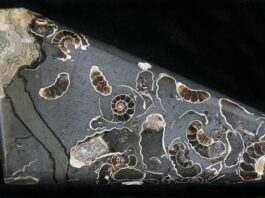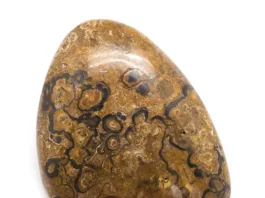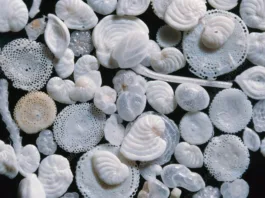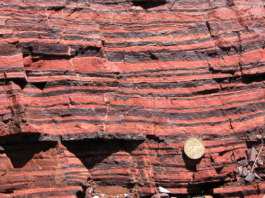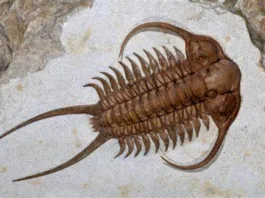Orthoceras is the name given to a genus of extinct marine cephalopods that lived during the Paleozoic Era, particularly in the Ordovician and Silurian periods, approximately 488 to 443 million years ago. The name “Orthoceras” is derived from the Greek words “orthos,” meaning straight, and “keras,” meaning horn, which refers to the characteristic long, straight, cone-shaped shells of these ancient creatures.

Definition of Orthoceras: Orthoceras is a type of nautiloid cephalopod, related to modern-day squids, octopuses, and nautiluses. The most distinctive feature of Orthoceras is its long, straight shell, which could reach lengths of up to several feet. The shell consists of a series of chambers that the animal used for buoyancy control, similar to the chambers in the shells of modern nautiluses.
Geological Context and Age: Orthoceras fossils are primarily found in marine sedimentary rocks from the Ordovician and Silurian periods. During this time, the Earth’s oceans were teeming with diverse marine life, and Orthoceras was one of the many species that thrived. Fossils of Orthoceras are commonly discovered in limestone and shale formations.
Importance of Orthoceras Fossils in Paleontology:
- Evolutionary Insight: Orthoceras fossils provide valuable insights into the evolutionary history of cephalopods, a class of marine animals that includes squids, octopuses, and nautiluses. Studying Orthoceras helps paleontologists understand the development and adaptation of these creatures over millions of years.
- Paleoecology: By examining the distribution of Orthoceras fossils within different rock formations, scientists can reconstruct ancient marine ecosystems. This information contributes to our understanding of the environmental conditions and ecological relationships during the Ordovician and Silurian periods.
- Stratigraphy: Orthoceras fossils are often used as index fossils, helping geologists date and correlate rock layers. The presence of Orthoceras in a particular sedimentary layer can indicate its approximate age and assist in establishing the relative chronology of geological formations.
- Educational and Aesthetic Value: The distinctive appearance of Orthoceras fossils, with their long, straight shells, makes them popular among collectors and enthusiasts. These fossils are often used in educational settings to teach about ancient marine life, paleontology, and Earth’s geological history.
In summary, Orthoceras fossils play a significant role in advancing our understanding of ancient marine life, evolution, and Earth’s geological history. Their well-preserved shells provide valuable information for researchers and contribute to the broader field of paleontology.
Contents
Morphology and Characteristics

The morphology and characteristics of Orthoceras fossils are distinctive and provide insight into the biology and lifestyle of these ancient cephalopods. Here are some key features:
- Shell Morphology:
- Straight Conical Shell: One of the most defining features of Orthoceras is its long, straight, conical shell. The shell is divided into numerous chambers, each added as the animal grew. The chambers are interconnected by a central tube known as the siphuncle.
- Chambers and Siphuncle: The chambers served as buoyancy chambers, enabling the animal to control its position in the water. The siphuncle, a tube running through the chambers, allowed for the regulation of gas and fluid within the shell, aiding in buoyancy control.
- Size:
- Orthoceras fossils vary in size, with some species having shells measuring only a few inches, while others could reach lengths of several feet. The size of the shell provided a clue to the species and the environmental conditions in which it lived.
- Body Structure:
- Orthoceras had a soft body that resided within the shell. The body had tentacles and other structures typical of cephalopods, although the details of the soft tissues are not usually preserved in the fossil record.
- Tentacles and Feeding:
- Like modern cephalopods, Orthoceras likely had tentacles that it used for capturing prey. These tentacles were likely equipped with suckers to secure and manipulate food. The organism was likely a carnivore, preying on small marine organisms.
- Habitat and Lifestyle:
- Orthoceras was a marine organism that lived in ancient oceans. Its straight shell and buoyancy chambers suggest an adaptation for a vertically oriented lifestyle in the water column. This allowed for efficient movement and navigation in the ancient seas.
- Preservation:
- Orthoceras fossils are often well-preserved, with the hard shells fossilizing over millions of years. The preservation of these fossils has allowed scientists to study the detailed structure of the shell and gain insights into the biology of these ancient cephalopods.
- Geographical Distribution:
- Fossils of Orthoceras have been found in various parts of the world, indicating a wide distribution during the Ordovician and Silurian periods. The presence of these fossils in different geological formations contributes to our understanding of ancient marine environments.
In summary, the morphology and characteristics of Orthoceras fossils, particularly the long, straight shell with buoyancy chambers, provide valuable information about the structure, lifestyle, and adaptation of these ancient cephalopods. While the soft tissues are rarely preserved, the well-preserved shells contribute significantly to our understanding of the evolutionary history of cephalopods and the ancient marine ecosystems in which they lived.
Geological Distribution

Orthoceras fossils have been found in various parts of the world, providing insights into the geographical distribution of these ancient cephalopods during the Ordovician and Silurian periods. Here are some notable regions where Orthoceras fossils have been discovered:
- North America:
- Orthoceras fossils are widespread in North America, with notable occurrences in regions such as the Appalachian Mountains, the Midwest, and parts of Canada. Fossil sites in the United States, including those in New York, Ohio, and Tennessee, have yielded well-preserved specimens.
- Europe:
- Fossils of Orthoceras have been found in several European countries, including the United Kingdom, Sweden, Estonia, and the Czech Republic. The Baltoscandian region, which includes parts of Scandinavia and the Baltic states, is known for its rich Orthoceras fossil deposits.
- Africa:
- Orthoceras fossils have been discovered in various parts of Africa, including Morocco and Algeria. The North African region, with its sedimentary rock formations, has yielded fossils that contribute to our understanding of the ancient marine life in the area.
- Asia:
- Fossils of Orthoceras have been reported in regions of Asia, including China and the Middle East. The geological formations in these areas have preserved evidence of ancient marine environments where Orthoceras thrived.
- Australia:
- While less common, Orthoceras fossils have also been found in Australia. The presence of these fossils contributes to the broader understanding of the global distribution of Orthoceras during the Paleozoic Era.
- South America:
- Fossil sites in South America, such as those in Argentina, have also yielded Orthoceras specimens. These findings contribute to the overall understanding of the distribution and diversity of marine life in ancient southern hemisphere oceans.
It’s important to note that the specific geological formations and rock layers where Orthoceras fossils are found vary across regions. The fossils are typically discovered in marine sedimentary rocks, such as limestone and shale, which have preserved the remains of these ancient cephalopods over millions of years.
The widespread distribution of Orthoceras fossils across continents supports the idea that these marine organisms were well-adapted to diverse environments and played a significant role in the marine ecosystems of the Ordovician and Silurian periods.
Collection and Preservation

Collecting and preserving Orthoceras fossils, like any fossil specimens, requires care and attention to ensure their integrity and scientific value. Here are some guidelines for collecting and preserving Orthoceras fossils:
1. Permission and Regulations:
- Before collecting fossils, be sure to obtain any necessary permits or permissions required by local authorities or landowners. Follow all regulations and ethical guidelines related to fossil collecting in the area.
2. Field Equipment:
- Essential field equipment includes rock hammers, chisels, brushes, and safety gear. A field notebook for recording the location, geological context, and any relevant information is also crucial for scientific documentation.
3. Field Identification:
- Learn to identify Orthoceras fossils in the field. Familiarize yourself with the distinctive features of their long, straight shells with chambers. Proper identification ensures accurate recording and documentation.
4. Site Selection:
- Orthoceras fossils are typically found in marine sedimentary rocks. Look for exposures of limestone, shale, or other sedimentary formations where fossils are likely to be preserved. Coastal areas, quarries, or exposed rock faces are common locations.
5. Extraction Techniques:
- Use appropriate tools for careful extraction to avoid damaging the fossils. Gentle brushing and scraping can help expose the fossil while minimizing the risk of breakage. Chisels and rock hammers can be used for larger specimens.
6. Handling:
- Handle fossils with clean, dry hands to avoid contamination. Avoid touching the fossilized surfaces whenever possible, as oils and moisture from skin contact can deteriorate the specimen over time.
7. Transportation:
- Securely wrap fossils in protective material, such as bubble wrap or foam, to prevent damage during transportation. Pack them in sturdy containers to minimize the risk of breakage.
8. Cleaning:
- Once the fossils are transported to a controlled environment, such as a laboratory or home, cleaning may be necessary. Use gentle cleaning methods, such as soft brushes or dental tools, to remove excess sediment and reveal the fossilized features.
9. Preservation:
- Some Orthoceras fossils may be prone to fragmentation or deterioration. Stabilize fragile specimens with consolidants or adhesives if necessary. Avoid using chemicals that may alter the appearance or composition of the fossils.
10. Documentation:
- Record detailed information about the specimen, including its location, geological context, and associated fauna and flora. Proper documentation is crucial for scientific research and may contribute valuable data to the understanding of the geological history of the area.
11. Display and Storage:
- If you intend to display the fossils, choose appropriate display cases and lighting to prevent damage from exposure to environmental elements. For long-term storage, use archival-quality materials and store fossils in a cool, dry place to minimize the risk of deterioration.
Always keep in mind that responsible and ethical collecting practices are essential for preserving the scientific and educational value of fossils. Additionally, sharing information about your findings with the scientific community can contribute to our collective understanding of Earth’s history.
Cultural and Commercial Significance

Orthoceras fossils hold cultural and commercial significance in various ways, contributing to both scientific and economic realms. Here are some aspects of their cultural and commercial importance:
Cultural Significance:
- Educational Value:
- Orthoceras fossils are valuable educational tools. Their distinctive appearance and the fact that they are well-preserved make them popular among educators, students, and enthusiasts. They are often used in schools, museums, and educational programs to teach about paleontology, evolution, and Earth’s history.
- Art and Decor:
- The unique and visually striking appearance of Orthoceras fossils makes them popular for artistic and decorative purposes. Fossils are often used in the creation of sculptures, jewelry, and other artistic pieces. Their spiral patterns and intricate details can be aesthetically pleasing.
- Symbolism:
- Fossils, including Orthoceras, may carry symbolic significance in various cultures. Some view fossils as symbols of ancient wisdom, evolution, or the passage of time. They can be incorporated into art, literature, or ceremonies to convey these symbolic meanings.
- Historical Connection:
- Fossils connect people to the Earth’s ancient past, providing a tangible link to the history of life on our planet. This connection fosters a sense of curiosity and wonder about the natural world and our place in it.
Commercial Significance:
- Fossil Collecting and Trading:
- Orthoceras fossils, like many other fossils, are collected by enthusiasts and traded in the commercial market. Collectors may seek well-preserved specimens to add to their personal collections, and dealers often facilitate the buying and selling of these fossils.
- Jewelry and Decor Items:
- Orthoceras fossils are often used in the creation of jewelry and decorative items. Polished and shaped fossils can be set in jewelry settings, such as pendants or earrings. Fossilized specimens are also incorporated into home decor items like bookends, tabletops, and display pieces.
- Tourism:
- Fossil-rich areas, where Orthoceras fossils can be found, may attract tourists and fossil enthusiasts. This can have economic implications for local communities through tourism-related activities such as guided fossil tours, museums, and souvenir sales.
- Scientific Research Funding:
- The commercial sale of fossils can contribute to funding scientific research. Paleontologists may purchase fossils for study, and funds generated from the sale of commercially valuable specimens may support further scientific exploration and excavation.
- Fossil Trade Shows:
- Fossil trade shows and exhibitions provide a platform for dealers, collectors, and enthusiasts to buy, sell, and exchange fossils, including Orthoceras. These events contribute to the commercial aspect of fossil trading and collecting.
While the commercial aspects provide economic opportunities, it’s crucial to balance these activities with ethical considerations. Responsible fossil collecting, adherence to regulations, and a focus on education and scientific understanding help ensure that the cultural and commercial significance of Orthoceras fossils is sustained in a positive and sustainable manner.

